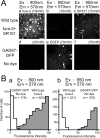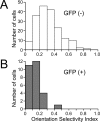GABAergic neurons are less selective to stimulus orientation than excitatory neurons in layer II/III of visual cortex, as revealed by in vivo functional Ca2+ imaging in transgenic mice
- PMID: 17314309
- PMCID: PMC6673543
- DOI: 10.1523/JNEUROSCI.4641-06.2007
GABAergic neurons are less selective to stimulus orientation than excitatory neurons in layer II/III of visual cortex, as revealed by in vivo functional Ca2+ imaging in transgenic mice
Abstract
Most neurons in the visual cortex are selectively responsive to visual stimulation of a narrow range of orientations, and GABAergic neurons are considered to play a role in the formation of such orientation selectivity. This suggests that response properties of GABAergic neurons may be different from those of excitatory neurons. This view remains unproved, however. To address this issue, we applied in vivo two-photon functional Ca2+ imaging to transgenic mice, in which GABAergic neurons express enhanced green fluorescent protein. Astroglia were stained by an astrocyte-specific dye. The three types of cells, GABAergic neurons, excitatory neurons, and astrocytes, in layer II/III of the visual cortex were differentially identified by using different wavelengths of excitation light and a dichroic mirror for emitted fluorescence, and their responses to moving visual stimuli at different orientations were measured with changes in the intensity of fluorescence of a Ca2+-sensitive dye. We found that almost all GABAergic neurons have orientation-insensitive responses, whereas most of excitatory neurons have orientation-selective responses.
Figures




References
-
- Albota MA, Xu C, Webb WW. Two-photon fluorescence excitation cross sections of biomolecular probes from 690 to 960 nm. Appl Opt. 1998;37:7352–7356. - PubMed
-
- Anderson JS, Carandini M, Ferster D. Orientation tuning of input conductance, excitation, and inhibition in cat primary visual cortex. J Neurophysiol. 2000;84:909–926. - PubMed
-
- Draeger UC. Receptive fields of single cells and topography in mouse visual cortex. J Comp Neurol. 1975;160:269–287. - PubMed
MeSH terms
Substances
LinkOut - more resources
Full Text Sources
Other Literature Sources
Miscellaneous
